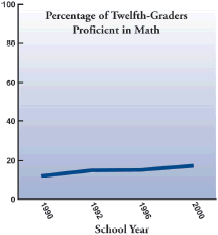 |
PDF (Unknown Size) |
The Challenge: America's schools are not producing the math excellence required for global economic leadership and homeland security in the 21st century.
The Solution: Ensure schools use scientifically based methods with long-term records of success to teach math and measure student progress. Establish partnerships with universities to ensure that knowledgeable teachers deliver the best instruction in their field.
HOW NO CHILD LEFT BEHIND HELPS IMPROVE MATH ACHIEVEMENT:
Math is a critical skill in the information age. We must improve achievement to maintain our economic leadership. While technology advances with lightning speed, stagnant math performance in schools shortchanges our students' future and endangers our prosperity and our nation's security.

|
Math achievement is improving slightly, but much more work must be done to ensure that our children receive a sound background in mathematics.
- According to the 2000 National Assessment of Educational Progress (NAEP), the average math scores of fourth- and eighth-graders, and twelfth-graders have improved only slightly.
- However, only a quarter of our fourth- and eighth-graders are performing at or above proficient levels in math. Twelfth-grade math scores have not improved since 1996, and a closer look at those scores reveals that the biggest drop occurred at the lowest levels of achievement. These are the students who most need our help and who can least afford to lose any more ground.
No Child Left Behind creates Math and Science Partnerships to rally every sector of society to work with schools to increase math and science excellence.
- The National Science Foundation and the U.S. Department of Education will provide an estimated $1 billion over five years for results-oriented partnerships between local districts and universities to bring urgency, tested methods, and high level expertise to rebuilding math excellence.
- Partnerships will invite businesses, science centers, museums and community organizations to unite with schools to improve achievement.
- The program rewards states for increasing participation of students in advanced courses in math and science and passing advanced placement exams.
- To ensure accountability, the Partnerships must report annually to the U.S. Secretary of Education on progress in meeting their set objectives, aligned to state standards.
The president has called for increasing the ranks and pay of teachers of math and science.
- No Child Left Behind requires states to fill the nation's classrooms with teachers who are knowledgeable and experienced in math and science by 2005. The president supports paying math and science teachers more to help attract experience and excellence.
Our nation must research the best way to teach math and science and measure students' progress in math.
- No Child Left Behind requires that federal funding go only to those programs that are backed by evidence.
- Over the last decade, researchers have scientifically proven the best ways to teach reading. We must do the same in math. That means using only research-based teaching methods and rejecting unproven fads.
- The new law also requires states to measure students' progress in math annually in grades 3-8 beginning in 2005.
|
|
|
|||||||||||
| |
||||||||||||

